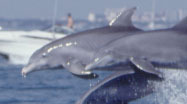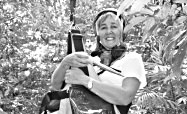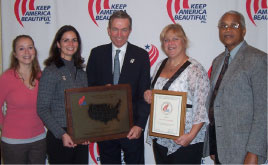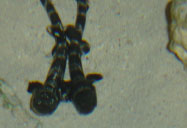 |
||||||||
 |

Break Out the Bottlenose Champagne
 The world’s longest-running wild dolphin research program is celebrating its 38th year documenting multi-generational residency of dolphins in Sarasota Bay. The program, which began in 1970, has documented the movements of nearly 150 dolphins in Sarasota Bay as well as 2,500 recognizable animals ranging from Tampa Bay south to Charlotte Harbor.
The world’s longest-running wild dolphin research program is celebrating its 38th year documenting multi-generational residency of dolphins in Sarasota Bay. The program, which began in 1970, has documented the movements of nearly 150 dolphins in Sarasota Bay as well as 2,500 recognizable animals ranging from Tampa Bay south to Charlotte Harbor.
A combined effort of Mote Marine Lab and the Chicago Zoological Society, the primary focus of the research is to better understand the structure and dynamics of dolphin populations, and the threats facing them.
Other recent research looked at the impact of red tide on coastal dolphin populations. Ironically, the toxic algal bloom did not directly cause dolphin deaths but the lack of prey fish apparently resulted in dolphin deaths caused as they stole bait from recreational anglers. An educational program teaching anglers how to deal with nearby dolphins and the problems caused by feeding wild dolphin is underway this year.
State Considers Harvest of Wild Peregrine Falcons
With peregrine falcon populations rebounding across the nation, the Florida Fish and Wildlife Conservation Commission is expected to complete a draft management plan for the birds. A stakeholder meeting has been set for January 28, including a video conference from the Florida Fish and Wildlife Research Institute in downtown St. Petersburg.
While the state management plan covers threat assessments, conservation goals and recommended conservation actions, the meeting is likely to focus on plans to allow recreational falconers to capture wild birds.
An assessment issued in December by the US Fish and Wildlife Service details a series of alternatives for capturing peregrine falcons, with the preferred alternative allowing for the capture of up to 36 first-year birds per year in the eastern US. Regional “flyway councils” are expected to work together to break that down to state levels, with the FWC having the option of allowing the capture of as many birds as determined by the council, allowing fewer birds or not allowing any birds at all to be captured in the state.
“Protecting habitat, particularly in the Florida Keys where birds migrating to south and central America stop before the final leg of their trip, is a top priority,” notes Kristina Jackson, research biologist with the FWC. Peregrines also spend the winter in coastal Florida.
For more information or to comment on the proposed management plan, contact Jackson at peregrine@myfwc.com.
Longleaf Ranked Among Nation’s Top 10 New Urbanism Communities
The Longleaf community in Pasco County was ranked No. 2 on NewUrbanMom.com’s annual list of the Top 10 New Urbanism Communities. The list ranks the top eco-friendly, diversified and affordable smart-growth neighborhoods in the nation.
“Longleaf was chosen because of its comprehensive focus not only on design, but on the elements that create a real sense of community,” said Sharon McMillan, publisher of NewUrbanMom.com. “From offering residents a real town ‘center’ to providing a good mix of residential housing choices, Longleaf is a community for our times.”
A traditional neighborhood development, Longleaf features a mixture of single-family homes, townhomes, apartments, an “A” rated elementary school, retail and recreation. Longleaf’s other environmental awards include Pasco County’s only certified “Green Development” from the Florida Green Building Coalition, a Grand Aurora Award for green construction from the Southeast Building Conference and one of only three Outstanding Florida-Friendly Community Awards from the Florida Yards & Neighborhoods program.
 Fulbright Board Taps Lowman
Fulbright Board Taps Lowman
Meg Lowman, professor of biology and environmental studies and director of environmental initiatives at New College of Florida, recently qualified for the Specialists Roster of the J. William Fulbright Foreign Scholarship Board.
The Fulbright Specialists Program is designed to provide short-term academic opportunities, ranging from two to six weeks, for U.S. faculty and professionals. Lowman will be placed with overseas academic institutions in countries where conservation, forest ecology or science education assistance is requested.
“It makes a difference for our environmental studies students to see faculty out there acting, not just talking, about environmental causes or conservation,” Lowman said. “And, with short visits, I can make an impact without having to be away from New College for a whole year.”
Lowman specializes in canopy ecology, science education and conservation biology. She also is working with Sarasota County to develop a biological field station for scientists and New College students and a Center for Progressive Land Use as a collaborative Florida-wide institution.
Keep Hillsborough County Beautiful Takes Top National Award
Keep Hillsborough County Beautiful took first place in the Keep America Beautiful Affiliates Award for its ongoing litter prevention, beautification and waste reduction efforts, community involvement, leveraging resources, media/public awareness, and recognition programs.
 In the past year, KHCB worked with 8,235 volunteers through various anti-litter programs cleaning 614 miles and 442 acres and collecting 180,393 pounds of trash. KHCB also expanded its beautification and recycling efforts by planting 700 plants, 235 trees and 599 flowers and diverting 108,270 pounds of recyclables from the county landfill through its school recycling grant program.
In the past year, KHCB worked with 8,235 volunteers through various anti-litter programs cleaning 614 miles and 442 acres and collecting 180,393 pounds of trash. KHCB also expanded its beautification and recycling efforts by planting 700 plants, 235 trees and 599 flowers and diverting 108,270 pounds of recyclables from the county landfill through its school recycling grant program.
For more information on becoming a volunteer, member or sponsoring an event, call 813-960-5121 or visit www.KHCBonline.org.
TBEP Receives $750,000 in Grants
The Tampa Bay Estuary Program has received nearly $750,000 in grants from local and national organizations to pursue research and restoration projects in Tampa Bay. The projects will involve numerous TBEP partners and will help to support the program’s many goals. The grants include:
• Feather Sound tidal wetland restoration project - With $346,090 from the Pinellas County Environmental Fund and $40,000 from the US Fish and Wildlife Service, TBEP and partners will develop restoration plans and obtain permits to restore 50 acres of degraded tidal wetlands along Feather Sound. Initial restoration of five acres may involve filling ditched canals and re-directing runoff from the nearby watershed.
• Development of a coordinated approach to compensatory mitigation in the bay watershed – With $250,000 from EPA Region IV, TBEP will explore whether mitigation performed by private entities can be used to advance the habitat restoration goals in the Tampa Bay watershed. Currently, areas restored as part of mitigation requirements do not count towards TBEP’s overall habitat goals.
• McKay Bay sediment quality action plan development - TBEP will receive $55,000 from the Hillsborough County Pollution Recovery Fund to define “hot spots” of sediment contamination in McKay Bay and develop action plans to remediate those areas.
• TBEP Bay Mini-Grants - The Pinellas County Environmental Fund will provide $50,000 to support the Bay Mini-Grants program by funding community-driven habitat restoration projects.
Baby Catsharks Hatch
 A trio of baby coral catsharks, a common but little-known nocturnal inshore shark native to the Indo-West Pacific Ocean, has been hatched at The Pier Aquarium.
A trio of baby coral catsharks, a common but little-known nocturnal inshore shark native to the Indo-West Pacific Ocean, has been hatched at The Pier Aquarium.
The births also mark a new phase for the aquarium, expanding its mission of education into a new focus on sustainable aquaculture, said E. Howard Rutherford, executive director.
“The status of concern for the coral catshark species is ‘near threatened,’” said Butch Ringelspaugh, curator of exhibits and “Head Nanny” at the aquarium. “By culturing these animals in captivity, we are lessening the need to harvest them from the wild. “Our goal is to eventually provide other aquariums with these aquacultured animals so they also can participate in more sustainable practices.”
However, he admitted, it’s the magic of the word “shark” that grabs people’s imaginations and attention. It also helps that the shark babies, untouched by human hands, look very cute and almost cuddly.
“What is intriguing to us is that little has been researched on the coral catshark’s reproduction,” Ringelspaugh said. He’s hopeful that the aquarium will provide data on gestation and survivability of the young sharks. “Then we can better understand these fascinating creatures and provide insight on how they can be successfully reproduced and reared in captivity,” he said.